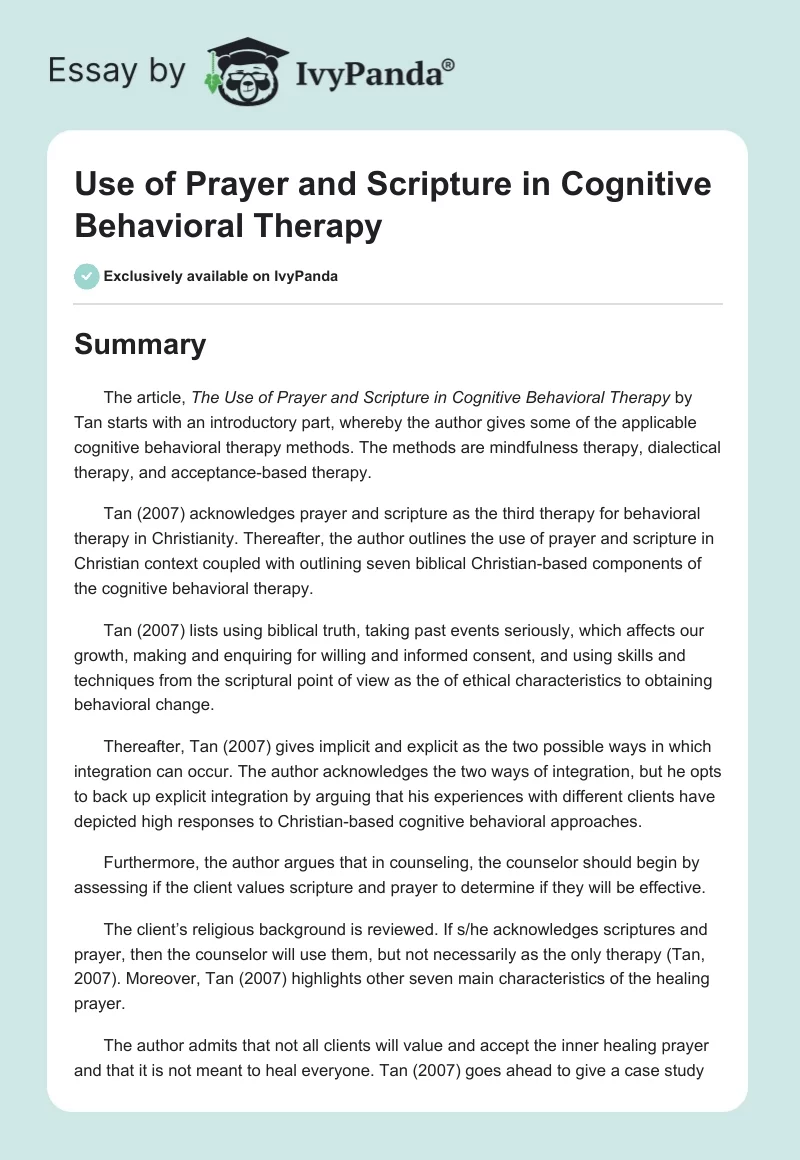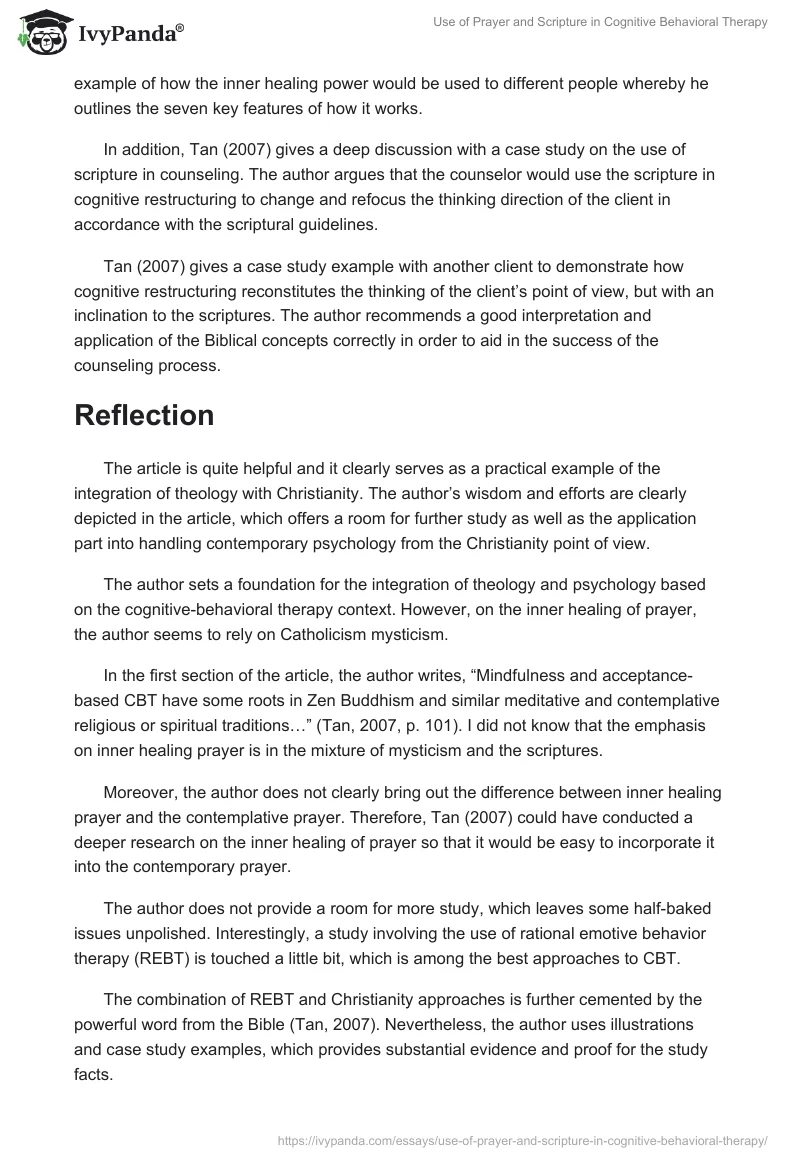Summary
The article, The Use of Prayer and Scripture in Cognitive Behavioral Therapy by Tan starts with an introductory part, whereby the author gives some of the applicable cognitive behavioral therapy methods. The methods are mindfulness therapy, dialectical therapy, and acceptance-based therapy.
Tan (2007) acknowledges prayer and scripture as the third therapy for behavioral therapy in Christianity. Thereafter, the author outlines the use of prayer and scripture in Christian context coupled with outlining seven biblical Christian-based components of the cognitive behavioral therapy.
Tan (2007) lists using biblical truth, taking past events seriously, which affects our growth, making and enquiring for willing and informed consent, and using skills and techniques from the scriptural point of view as the of ethical characteristics to obtaining behavioral change.
Thereafter, Tan (2007) gives implicit and explicit as the two possible ways in which integration can occur. The author acknowledges the two ways of integration, but he opts to back up explicit integration by arguing that his experiences with different clients have depicted high responses to Christian-based cognitive behavioral approaches.
Furthermore, the author argues that in counseling, the counselor should begin by assessing if the client values scripture and prayer to determine if they will be effective.
The client’s religious background is reviewed. If s/he acknowledges scriptures and prayer, then the counselor will use them, but not necessarily as the only therapy (Tan, 2007). Moreover, Tan (2007) highlights other seven main characteristics of the healing prayer.
The author admits that not all clients will value and accept the inner healing prayer and that it is not meant to heal everyone. Tan (2007) goes ahead to give a case study example of how the inner healing power would be used to different people whereby he outlines the seven key features of how it works.
In addition, Tan (2007) gives a deep discussion with a case study on the use of scripture in counseling. The author argues that the counselor would use the scripture in cognitive restructuring to change and refocus the thinking direction of the client in accordance with the scriptural guidelines.
Tan (2007) gives a case study example with another client to demonstrate how cognitive restructuring reconstitutes the thinking of the client’s point of view, but with an inclination to the scriptures. The author recommends a good interpretation and application of the Biblical concepts correctly in order to aid in the success of the counseling process.
Reflection
The article is quite helpful and it clearly serves as a practical example of the integration of theology with Christianity. The author’s wisdom and efforts are clearly depicted in the article, which offers a room for further study as well as the application part into handling contemporary psychology from the Christianity point of view.
The author sets a foundation for the integration of theology and psychology based on the cognitive-behavioral therapy context. However, on the inner healing of prayer, the author seems to rely on Catholicism mysticism.
In the first section of the article, the author writes, “Mindfulness and acceptance-based CBT have some roots in Zen Buddhism and similar meditative and contemplative religious or spiritual traditions…” (Tan, 2007, p. 101). I did not know that the emphasis on inner healing prayer is in the mixture of mysticism and the scriptures.
Moreover, the author does not clearly bring out the difference between inner healing prayer and the contemplative prayer. Therefore, Tan (2007) could have conducted a deeper research on the inner healing of prayer so that it would be easy to incorporate it into the contemporary prayer.
The author does not provide a room for more study, which leaves some half-baked issues unpolished. Interestingly, a study involving the use of rational emotive behavior therapy (REBT) is touched a little bit, which is among the best approaches to CBT.
The combination of REBT and Christianity approaches is further cemented by the powerful word from the Bible (Tan, 2007). Nevertheless, the author uses illustrations and case study examples, which provides substantial evidence and proof for the study facts.
Therefore, the article is a reliable, and thus an additional reading list for further research and knowledge.
Application
The author’s approach can be used to counsel addicted clients, specifically sexual addiction victims under the influence of watching pornography. For instance, a client may present and narrate his/her addiction to sexual experiences and request for a Christian-based CBT.
The therapist/pastor would request the client to refresh the pornographic images to the mind. The therapist/pastor will then conduct an inner healing prayer to show the client how the sin associated with the images displeases God. The counselor will further show the client how Christ can free his/her mind from those evil thoughts.
Moreover, the client would be instructed to replace those images with those of Christ and how sweet and free it is to have a functional relationship with our Savior.
Furthermore, the scriptures would be used to counterattack the images in the client’s mind. The verses, Romans 12:1-2, would be applicable whereby one is transformed through freeing of the mind.
In addition, another useful verse would be Romans 7 about the war whereby Paul does what he does not intend to do even though he wants to do the right things. The counselor would then go further to read and interpret Romans 8 whereby the scripture emphasizes sanctification.
The clients would be shown how Christ would free him/her from the dead. Therefore, combining the two approaches, viz. prayer and scripture, would help free the client from sexual addiction.
The client would apply the imagery of Christian techniques to imagine the relationship with Christ who frees him/her from sexual addiction. Furthermore, the client would keep meditating on the scriptures to keep enhancing and improving her/his self-esteem.
Therefore, through the power of the prayer and scripture, the client would confront and control all dysfunctional perspectives and thinking patterns.
Conclusion
There is power in prayer and the scriptures. Prayer and the scriptures enliven the faith, hope, trust, and the anxiety of a believer in Christ. Therefore, integrating prayer, the scriptures, and psychology solves many contemporary issues.
The article provides the basic elements for survival in Christianity and helping others to overcome burdens and temptations encountered in daily living.
Reference
Tan, S. (2007). Use of prayer and Scripture in Cognitive Behavioral Therapy. Journal of Psychology and Christianity, 26(2), 101-111.


